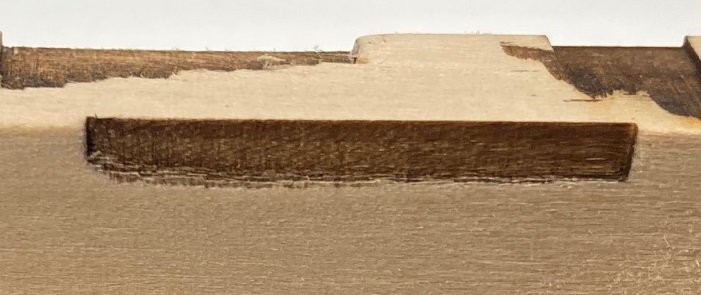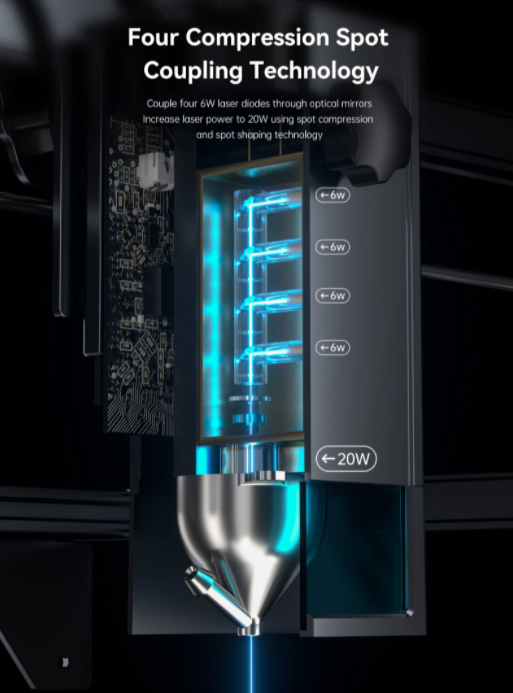I wanted to finish up my investigation into speed vs power and how it relates to cut depth. Previously I worked out the relationship depth = (power * passes) / (speed * spot_size). And I was able to demonstrate that depth increases linearly with power, and decreases logarithmically with speed. Next I found that there is (approximately) a linear relationship between power and passes.
The next part of the equation that I have not covered is the relationship between speed and power. The theory is that if you increase speed you can increase power at a fixed rate to get the same depth of cut.

After a bit of experimentation to dial it in I came up with the equation speed (mm/min) = power (%) * 700. Varying power from 0.10 to 0.80 (10% to 80%) at speeds from 70 mm/min to 560 mm/min produced the above cut that shows there is in fact a linear relationship between speed and power over at least most of the range. This was done with my NEJE A40640 laser module. The scaling factor would be different for a different power laser.
It is hard to visualize what is going on in the above image but the laser was accelerating from 70 mm/min to 560 mm/min as it traveled left to right, while the laser power was increasing from 10% to 80 % over the same range. Both were increasing at a linear rate. There is a small increase in depth of cut from 10% power to 30% power, that could just be caused by my scale factor being a bit low. It is quite possible that using 800 could have straightened things out, but I ran out of steam after having run quite a few other test cuts previously.
The only big thing left to investigate is how spot size effects depth of cut. However I don't know that I'm well equipped to study that, or at least I can't think of a good way to measure spot size with enough reliability at this time. Maybe I could try running a ramp test on a piece of anodized aluminum and get reliable measure of spot size from that. However in my past experiments with this, the spot size did not seem to change much over the range I could run the ramp over.
---

Atomstack has announced a new X20 Pro laser cutter that has 4 5w diodes stacked up in it. That would make it 2x more powerful than my NEJE A40640 module. It also cost a bit more at $1,000 for a smallish 400x400 mm machine with built in air assist. There claiming they can cut 12 mm deep in one pass and can even cut thin sheet metals. I have a feeling they are not wrong on all of that my module is impressive all by itself, if it was 2x stronger it would probably bee too powerful for my machine. that is when engraving at least I would be unable to run fast enough to keep up. There machine is rated at a max speed of 12,000 mm/min or 200 mm/sec. That is in line with the speed range of a CO2 laser.
I had thought that 2 diodes was all you could stack up in a laser, and still have the beams running right on top of each other. This is because my module uses a neat trick where you use a polarized mirror to make the mirror transparent when the laser is oriented in one direction and reflective when oriented in the other so that one laser can pass through the mirror and the other is reflected and combined. This works because part of what makes a laser a laser is that the output is polarized, that is all the light waves are oriented in the same direction and orientation. However it turns out there are in fact other methods of combining lasers, they are just not as simple or as inexpensive.
They also offer a honeycomb bed, although it is a bit undersized for this machine, a rail extension kit, a rotary kit, and even a full metal enclosure. However if you went all in you would be dropping $1,600 on a machine that is probably underpowered compared to a glow forge or 50w CO2 machine. The only real advantage here is that you can drop the water cooler for a much simpler setup, maintenance wise. However I do expect this to come down in price over time and expect to start seeing fully enclosed dual and quad diode laser modules under $1,000 in the next 4-5 years. Considering a glowforge starts at $4,000 having a quad diode enclosed for $1,000 would be very competitive.
 David Tucker
David Tucker
Discussions
Become a Hackaday.io Member
Create an account to leave a comment. Already have an account? Log In.